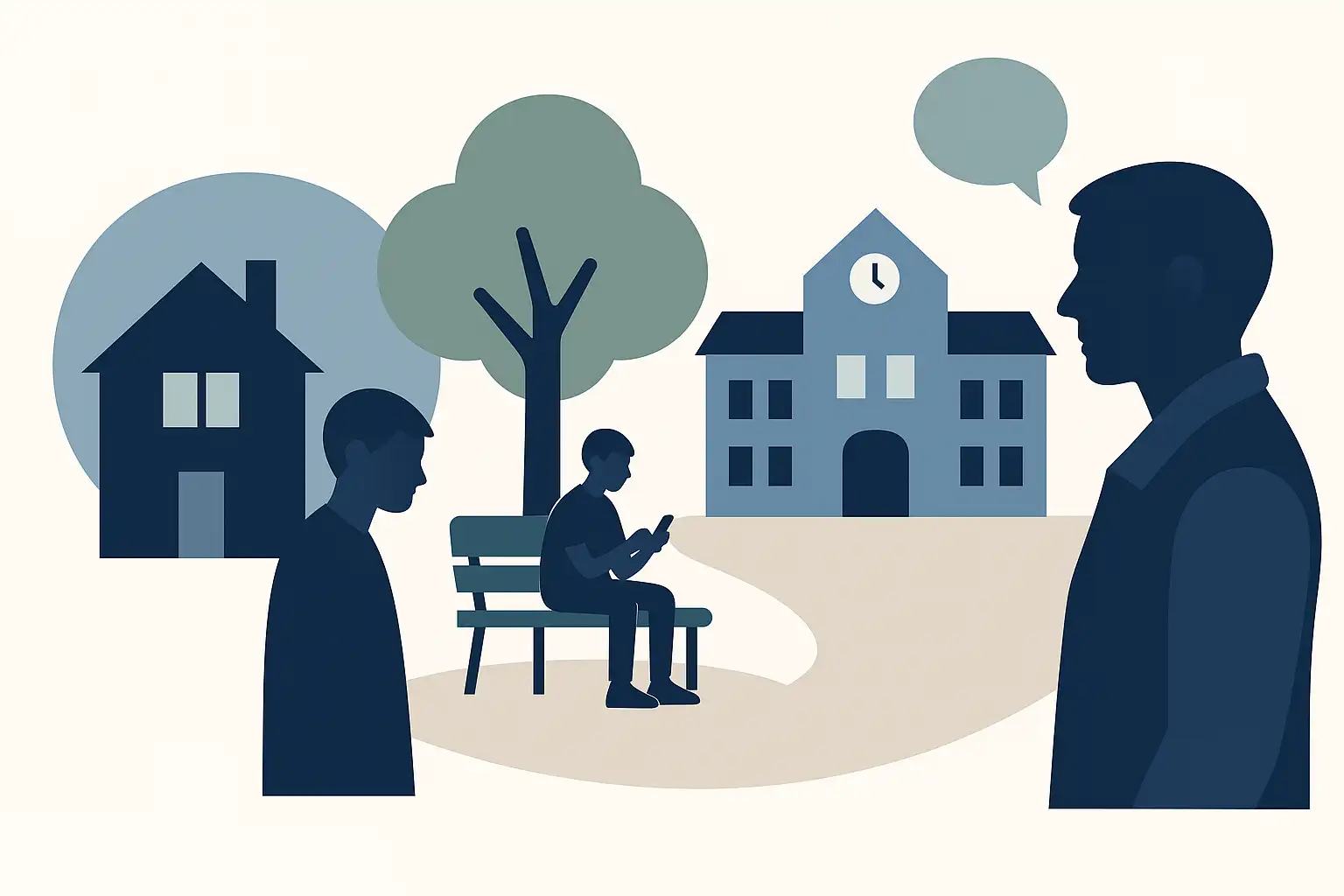Contextual safeguarding recognises that protecting children means keeping them safe in every environment, not just at home. Learn how Welcare applies this approach to build safer communities and stronger futures for young people across the UK.
Every child deserves to grow up feeling safe, supported, and cared for. Yet many of the risks young people face today happen outside their family homes. Whether at school, in the community, or online, the world around a child can strongly influence their wellbeing. That is why contextual safeguarding has become such an important part of modern child protection.
Contextual safeguarding recognises that harm does not only occur within the family. It can also take place in social environments where parents or carers may have limited control. These include schools, parks, neighbourhoods, and digital spaces. This approach helps professionals, care providers, and communities work together to protect children wherever they spend their time.
At Welcare Children’s Homes, safeguarding extends beyond the walls of our homes. We believe that to protect a child, we must understand every part of their world. This means being aware of their friendships, their online activities, and the places they visit in their local area. Our teams are trained to identify potential risks early and to respond with empathy, care, and collaboration.
Welcare’s approach aligns with Ofsted and Department for Education guidance on safeguarding in residential care. It ensures that children are not only safe where they live, but also supported to navigate the wider environments that shape their lives.
What Is Contextual Safeguarding?
The term contextual safeguarding was developed by Dr Carlene Firmin at the University of Bedfordshire. Her research highlighted that many young people experience harm in settings outside the family, where traditional safeguarding systems have less influence. This could include exploitation, bullying, or criminal activity involving peers.
In simple terms, contextual safeguarding means recognising and responding to harm that happens in social environments beyond the home. It expands the focus of child protection to include all areas of a child’s daily life, not just their family relationships.
Children interact with multiple social contexts every day. Each of these can affect their safety, confidence, and wellbeing. These include:
- Peer groups where young people may face pressure, control, or exclusion.
- Schools and colleges where issues such as bullying, neglect, or exploitation can arise.
- Neighbourhoods and communities that may expose children to crime, violence, or unsafe adults.
- Online spaces where children can experience cyberbullying, grooming, or exposure to harmful content.
The goal of contextual safeguarding is to understand how these environments influence risk and to intervene where harm occurs. It promotes early identification, prevention, and strong partnerships between professionals and the community.
Contextual Safeguarding Meaning
The meaning of contextual safeguarding lies in its ability to look beyond individual behaviour and consider the broader influences on a child’s life. It recognises that children are shaped by the people, places, and experiences around them. This approach asks not only “what happened?” but also “where and why did it happen?”
At Welcare, this understanding guides every aspect of our work. Our teams take a proactive approach by:
- Building strong and trusting relationships so children feel safe to speak up.
- Conducting environmental risk assessments to understand external influences.
- Collaborating with schools, local authorities, and the police to share information and act quickly.
- Providing education on online safety, peer influence, and emotional wellbeing.
Through this, we help young people build resilience and make informed, positive choices about their relationships and environments.
Why It Matters in Residential Care
For children and young people living in residential care, contextual safeguarding is especially important. Many have faced difficult or traumatic experiences before entering care and may be more vulnerable to external pressures. A safeguarding approach that focuses only on the home does not capture the full picture of their lives.
At Welcare, our safeguarding framework ensures that every child’s care plan includes both internal and external safety considerations. This means understanding how school, peer groups, and community life interact with their emotional and psychological wellbeing. Staff receive continuous training to identify early signs of contextual risk and respond in ways that are sensitive and supportive.
We work closely with social workers, schools, and local safeguarding partnerships to create a joined-up approach. By doing so, we make sure that young people are not only safe inside our homes but also confident to make safe decisions beyond them.
When children feel secure, listened to, and empowered, they can truly begin to heal, grow, and thrive. That is the purpose of contextual safeguarding: protecting the whole child in every part of their world.

What Contextual Safeguarding Recognises
Understanding What Contextual Safeguarding Recognises
At its core, contextual safeguarding recognises that children’s lives are shaped by more than just their families. It acknowledges that harm can occur in many different environments, often involving peers or community influences rather than direct family members. This approach accepts that the social settings around children can be both protective and risky, and that effective safeguarding must consider every context where young people spend time.
This is a shift from traditional safeguarding, which focuses mainly on what happens inside the home. Contextual safeguarding recognises that even when family relationships are stable and positive, young people may still face danger elsewhere. For example, a child could be drawn into risky peer groups, experience bullying at school, or be influenced by harmful online content.
For professionals and carers, the key question is not only “Is this child safe at home?” but also “Are they safe in their wider world?”
The Four Key Contexts of Risk and Protection
The contextual safeguarding framework identifies four key areas that strongly influence a child’s safety. Each of these contexts can either support or undermine a young person’s wellbeing. Understanding them helps carers and professionals to assess risk more holistically and take early action when needed.
1. Peer Relationships
Young people often spend more time with friends than with family. Peer groups can be a source of comfort, belonging, and identity, but they can also be where harmful behaviours begin. Contextual safeguarding recognises that peer relationships can lead to risks such as peer-on-peer abuse, exploitation, or coercion.
In some cases, a young person might feel pressure to take part in harmful activities to maintain their friendships or status within a group. At Welcare, staff are trained to recognise the signs of unhealthy peer influence, including changes in behaviour, isolation, or secrecy. We work with children to strengthen their confidence, promote healthy friendships, and develop their ability to make positive choices.
2. Schools and Education Settings
Schools play a vital role in safeguarding. They are environments where young people form friendships, learn social skills, and build resilience. However, they can also be places where bullying, exclusion, or sexual harassment occur. Contextual safeguarding highlights that schools must be part of the wider protective network around children.
At Welcare, we collaborate closely with schools to share information about potential risks and ensure consistency in safeguarding plans. When a child in our care attends school, our staff maintain regular communication with teachers and pastoral teams. This partnership helps us respond quickly to early signs of harm and provide coordinated support.
3. Neighbourhoods and Communities
The areas where children live and socialise can greatly affect their sense of safety. In some neighbourhoods, exposure to crime, anti-social behaviour, or unsafe adults can increase vulnerability. Contextual safeguarding recognises that community spaces can both help and harm, depending on how well they are managed and monitored.
Welcare’s teams take time to understand the local environments where our children spend time. This includes mapping safe routes, identifying potential risks, and building relationships with community groups and local authorities. By engaging positively with the community, we help create safer spaces where children can explore and grow with confidence.
4. Online Environments
The online world is now a major part of every young person’s life. It offers connection, creativity, and learning opportunities, but it can also expose children to serious harm. Contextual safeguarding recognises the online environment as a social space in its own right. Risks such as grooming, radicalisation, exposure to inappropriate content, and cyberbullying are increasingly common.
At Welcare, we take online safety seriously. Our staff and children receive regular guidance on safe internet use. We provide age-appropriate digital literacy education and create open spaces for conversation about online experiences. By helping young people build digital resilience, we reduce the likelihood of online harm and promote responsible use of technology.
Recognising Contextual Harm Early
One of the strengths of contextual safeguarding is its focus on early identification. Recognising patterns of harm as they emerge allows professionals to act before risks escalate. This involves observing behaviour changes, listening carefully to what children say, and paying attention to the social groups they belong to.
For example, if a child suddenly avoids school or changes their peer group, it could be a sign of contextual risk. Staff at Welcare are trained to approach these situations with sensitivity. Instead of judging or assuming, they explore the child’s environment and experiences. This helps uncover the underlying context of harm and guides the most appropriate intervention.

How Welcare Applies These Principles
At Welcare Children’s Homes, contextual safeguarding is not just a policy but a daily practice. Our approach includes:
- Partnership working with schools, local authorities, and community agencies.
- Regular environmental assessments to understand the social and geographical influences on each child’s safety.
- Open communication between children, staff, and families to identify risks early.
- Therapeutic support to help young people process experiences of harm and build confidence.
By understanding what contextual safeguarding recognises, we can better protect children from the influences that exist beyond the home. Every context matters, and by working together, we can make each one safer.
Principles and Practice of Contextual Safeguarding
The Principles Behind Contextual Safeguarding
The foundation of contextual safeguarding is the understanding that children’s safety is influenced by a range of environments and relationships. It moves beyond family-focused assessments to include the broader systems that shape a young person’s life.
This approach is guided by several key principles that help professionals identify, assess, and respond to risk effectively.
1. Multi-Agency Collaboration
Safeguarding is most effective when everyone involved works together. No single organisation can address all aspects of a child’s safety. Multi-agency collaboration allows professionals to share information, coordinate responses, and make well-informed decisions.
At Welcare, our teams maintain strong partnerships with schools, police, local safeguarding boards, and healthcare services. These partnerships create a joined-up approach where all agencies understand the unique needs of each child. By sharing insights and acting together, we can reduce duplication, close gaps in communication, and ensure a consistent standard of protection across every environment.
2. A Child-Centred and Relational Approach
Contextual safeguarding is rooted in respect, empathy, and genuine connection. It values children’s voices and acknowledges that they are experts in their own experiences. This principle focuses on listening to young people and building trust so they can express concerns openly.
At Welcare, staff take the time to understand the individual behind the behaviour. Instead of responding only to incidents, they look at the context, relationships, and emotions that might sit beneath them. This relational approach helps young people feel seen, heard, and supported, which is vital for recovery and growth.
3. Strength-Based Prevention
A preventive approach is essential for long-term impact. Contextual safeguarding aims to strengthen protective factors in every setting where children live and learn. This includes fostering positive peer relationships, creating safer community spaces, and promoting digital safety.
Welcare encourages young people to take part in structured activities, social skill development, and therapeutic programmes that build resilience. Our focus is on equipping children with the confidence and awareness to make safe, informed decisions.
When prevention is embedded in care practice, safeguarding becomes a proactive effort rather than a reactive response.
How Contextual Safeguarding Strengthens Practice in Children’s Homes
Applying contextual safeguarding in a residential care environment means constantly assessing how a young person’s surroundings affect their safety and wellbeing. It helps care professionals move from isolated observations to a holistic understanding of risk.
At Welcare, this begins with a comprehensive contextual assessment. Each child’s plan considers their social networks, school environment, digital footprint, and local community. These assessments help staff anticipate where harm could occur and work with relevant partners to reduce it.
For example, if there are concerns about community safety, staff will liaise with local authorities and community groups to ensure safe routes to school or leisure facilities. If peer influence is a factor, we work with education providers to encourage positive friendships and promote inclusive learning environments.
Contextual safeguarding also strengthens reflective practice among staff. Regular supervision sessions and safeguarding reviews allow team members to discuss patterns, share concerns, and adapt strategies as risks evolve. This process ensures that safeguarding is dynamic and responsive rather than fixed.
In doing so, Welcare creates an environment where safety is not only maintained within our homes but extended into the wider community. Every staff member becomes part of a collective effort to protect children in all the spaces they inhabit.

Training and Professional Development
High-quality training is essential for sustaining contextual safeguarding practice. Risks evolve quickly, especially with the rise of digital and social media influences. Professionals need to understand how these contexts change and how to adapt their safeguarding approaches accordingly.
At Welcare, contextual safeguarding is integrated into staff development from the very beginning. Every new team member receives detailed training during induction, followed by ongoing workshops and reflective practice sessions. These sessions allow staff to explore real-world safeguarding scenarios, analyse environmental influences, and strengthen decision-making skills.
The training also includes education on trauma-informed care, online safety, and inter-agency communication. This ensures that every adult working in our homes understands how to identify contextual risk and respond in a way that is empathetic, coordinated, and effective.
Continuous learning builds confidence and competence. It also reinforces a shared culture of vigilance, empathy, and accountability — the foundations of truly effective safeguarding.
Why This Approach Works
When contextual safeguarding is embedded across every level of practice, children’s homes become more connected to the communities around them. Instead of viewing safeguarding as a checklist or procedure, it becomes a living, responsive process that evolves alongside each young person’s circumstances.
At Welcare, this approach creates stronger outcomes. Young people develop safer relationships, staff grow more confident in their professional judgment, and communities become active participants in protecting children.
By placing context at the heart of safeguarding, we make sure that every environment contributes to safety, stability, and trust.
The Future of Contextual Safeguarding
Collaboration and Shared Responsibility
The future of contextual safeguarding lies in collective responsibility. Protecting children from harm cannot rest on one professional, one setting, or one service. It requires everyone in a child’s life to work together, from social workers and teachers to community leaders, youth mentors, and digital platforms.
This shared approach recognises that the environments children move through each day overlap and influence one another. A positive school experience can be undone by unsafe neighbourhood conditions, just as supportive friendships can be threatened by harmful online influences.
At Welcare Children’s Homes, collaboration forms the heart of our safeguarding practice. We regularly liaise with local safeguarding partnerships, Ofsted inspectors, therapeutic practitioners, and community agencies. This ensures that every young person in our care benefits from a safety network that extends well beyond the home.
We believe that everyone has a role to play. Community members can act as protective figures by remaining alert to risks and offering safe spaces for children. Schools can implement robust anti-bullying and peer mentoring programmes. Online providers can strengthen safety controls and educate users. By working together, we create the secure, supportive communities that children deserve.
Challenges in Implementation
Despite growing recognition, contextual safeguarding is not without its challenges. Local authorities, care providers, and professionals must navigate limited resources, competing priorities, and varying interpretations of what the approach means in practice.
One challenge is ensuring consistency. While some local areas have advanced contextual safeguarding partnerships, others are still developing frameworks to embed this approach into policy. Another is ensuring that interventions are both protective and proportionate. A child’s social environment may present risks, but it can also offer strength and identity.
Welcare’s focus is to find that balance. We aim to identify risk while preserving the positive aspects of each child’s social world. For example, a friendship group may expose a young person to harm, but with the right support and mediation, it could also become a powerful source of resilience.
Ongoing staff training is essential to meeting these challenges. Contextual safeguarding is a dynamic field, constantly shaped by emerging risks such as online radicalisation, coercive control, and peer-based exploitation. Professionals must stay informed, reflective, and responsive.
Innovation and the Role of Data
Technology and data analysis are becoming increasingly important in identifying patterns of harm. Mapping tools can help professionals visualise where risks occur in a community, allowing for more targeted prevention. At the same time, safeguarding must respect confidentiality and human connection.
Welcare’s approach combines digital awareness with relational care. Our staff are trained to understand how online risks intersect with real-world vulnerabilities. Through ongoing education and collaboration with schools and local authorities, we promote healthy digital engagement rather than fear-based restriction.
We are also committed to learning from the wider sector. Organisations such as Action for Children and Homes2Inspire have shown that using shared data across local networks can dramatically improve early intervention outcomes. As more providers embrace this integrated model, children will benefit from more joined-up and effective protection.
The Future Vision for Contextual Safeguarding
The vision for contextual safeguarding in the UK is one where every environment that shapes a child’s life becomes a source of safety and support. Schools will see safeguarding as part of their culture, communities will see it as a shared duty, and care homes will continue to lead by example.
At Welcare, this vision is becoming reality. Our homes are not isolated environments but part of a larger ecosystem of care. We believe that when children experience consistent, compassionate protection in all areas of their life, they begin to rebuild trust and confidence.
The future will also see a stronger link between contextual safeguarding and therapeutic care. Understanding the social context of harm allows therapeutic teams to tailor interventions that address both internal and external influences. By combining these approaches, we can help children not only recover from trauma but also build lasting resilience.
Building Safer Futures Together
As the UK continues to strengthen its safeguarding frameworks, contextual safeguarding represents the next step forward in child protection. It reminds us that keeping children safe means understanding every part of their world.
At Welcare Children’s Homes, we remain committed to leading this approach through empathy, professionalism, and partnership. By working together with families, schools, local authorities, and communities, we can create environments where every child feels valued and secure.
The goal of contextual safeguarding is simple yet powerful: to protect children not only where they live but everywhere they grow, learn, and belong.
Read More
Got a question?
Frequently Asked Questions
What is contextual safeguarding?
Contextual safeguarding is a modern approach to child protection that looks beyond the family home. It focuses on the environments where children spend their time, such as schools, neighbourhoods, peer groups, and online spaces. It helps professionals understand how these environments influence a young person’s safety, relationships, and wellbeing.
What does contextual safeguarding recognise?
It recognises that harm can occur in a child’s wider world, not only within the family. This includes risks like bullying, exploitation, radicalisation, gang involvement, and online grooming. By identifying and responding to these risks, professionals can protect children more effectively in every area of their lives.
Why is contextual safeguarding important?
Traditional safeguarding systems focus mainly on parental responsibility. Contextual safeguarding expands this view to include community and social contexts. It is important because it acknowledges that even when children have loving families, they can still face harm from peers, social media, or unsafe community environments. It allows professionals to take early, coordinated action to address risks before they escalate.
How does contextual safeguarding apply in children’s homes?
In residential care, contextual safeguarding helps staff understand how a young person’s world outside the home affects their behaviour and wellbeing. At Welcare Children’s Homes, this means assessing local environments, monitoring peer relationships, supporting online safety, and working closely with schools and social workers. It ensures that children are safe not only in the home but in every aspect of their daily life.
What are the four main contexts in contextual safeguarding?
The four key contexts are:
Peer groups – where friendships or social pressure can lead to risk.
Schools and colleges – where exclusion, bullying, or exploitation can occur.
Neighbourhoods and communities – where exposure to unsafe adults or criminal activity may happen.
Online spaces – where digital interactions can create new risks such as grooming or cyberbullying.
Who is responsible for contextual safeguarding?
Contextual safeguarding is everyone’s responsibility. It requires collaboration between families, schools, care providers, local authorities, police, and community groups. Each has a role in recognising risk and creating safe environments for children. At Welcare, we believe safeguarding is strongest when it is shared.







